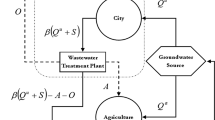Abstract
This study analyzed the effects of population and urban growth on water demand for irrigation and other water users, as well as municipal wastewater quantity changes, by developing a new mathematical model. The model was developed to consider the potential for reuse of treated wastewater for agricultural irrigation, by analyzing the increasing quantity of wastewater production in an urban area. It was applied to a case study in Logan, Utah, whereby results from the model showed a total water demand of 0.7 and 1.27 m3/s in 2020 and 2050, respectively, while the model predicted that the average wastewater influent for Logan City would be more than double from 2010 to 2050. Accordingly, a model-predicted increase of 16% in the annual production of wastewater was observed from 2010 to 2025. The amount of wastewater production in 2030 was estimated to be 14.2 million m3/year, which is enough to produce food from irrigated agriculture for 11% of the future population of Logan City. This emphasizes the potential importance of reusing wastewater for irrigated agriculture. Water conservation was also studied and it showed that a 5% conservation of water volume could cover the needs of an additional 4.2 thousand people in 2030.




Similar content being viewed by others
References
Abughlelesha SM, Lateh HB (2013) A review and analysis of the impact of population growth on water resources in Libya. World Appl Sci J 23(7):965–971
Ahmadi L, Merkley G (2008) Planning and management modeling for treated wastewater usage. USCID Conference on Urbanization of Irrigated Land and Water Transfers, Scottsdale, Arizona
Allen RG, Pereira LS, Raes D, Smith M (1998) Crop evapotranspiration: guidelines for computing crop requirements. FAO Irrigation and Drainage Paper, No. 56, Rome, Italy
Anderson MT, Woosley LH Jr (2005) Water availability for the Western United States—key scientific challenges, US Geological Survey, Circular 1261, Reston, Virginia, p 85
Bernstein S (2002) Freshwater and human population: a global perspective. Yale F&ES Bull 107:149–157
Cooper SD, Lake PS, Sabater S, Melack JM, Sabo JL (2013) The effects of land use changes on streams and rivers in mediterranean climates. Hydrobiologia 719:383–425
Davis WY, Rodrigo DM, Opitz EM, Dziegielewski B, Baumann DD, Boland JJ (1988) IWR-MAIN Water Use Forecasting System, Version 5.1: user’s manual and system description. US Army Corps of Engineers, IWR Report 88-R-6
Dixon B, Earls J (2012) Effects of urbanization on streamflow using SWAT with real and simulated methodological data. Appl Geogr 35(1–2):174–190
Dziegielewski B, Boland JJ (1989) Forecasting urban water use: the IWR-MAIN model. J Water Resour Assoc 25(1):101–109
Fort DD (2002) Water and population in the American West. Yale F&ES Bull 107:17–24
Fulton W, Pendall R, Nguyen M, Harrison A (2001) Who sprawls most? How growth patterns differ across the US. The Brookings Institution, Survey series, Center of Urban and Metropolitan Policy
Hansen, Allen & Luce Inc. (2007) Logan city wastewater collection system master plan, Final report
Hutson S (1996) Estimates of future water demand for selected water-service areas in the Upper Duck River Basin, Central Tennessee, US Geological Survey, Water Resources Investigations Report 96-4140
Kiniouar H, Hani A, Younsi A (2017) Assessing long-term water demand of Constantine province in Kébir–Rhumel Mediterranean catchment. AIP Conference Proceedings, vol 1814, No. 1
Leao S, Bishop I, Evans D (2004) Simulation urban growth in a developing nation’s region using a cellular automata-based model. J Urban Plan D-ASCE 130:145–158
Logan City (2007) Logan City master plan
Logan City (2011a) Water conservation plan. http://www.loganutah.org/PW/water_and_waste_water/documents/Water%20Conservation.pdf. Accessed Sept 2015
Logan City, Environmental Department (2011b) Personal communication, Logan, UT
Logan Municipal Library (2011) Community profile. http://library.loganutah.org/local/profile/population.cfm. Accessed Sept 2015
Maliehe M, Mulungu DMM (2017) Assessment of water availability for competing uses using SWAT and WEAP in South Phuthiatsana catchment, Lesoth. Phys Chem Earth Parts A/B/C. 10.1016/j.pce.2017.02.014
Malthus TR (1798) An essay on the principle of population. Oxford University Press, Oxford
Mancosu N, Snyder RL, Kyriakakis G, Spano D (2015) Water scarcity and future challenges for food production. Water 7:975–992
McDonald RI, Green P, Balk D, Fekete BM, Revenga C, Todd M, Montgomery M (2011) Urban growth, climate change, and freshwater availability. PNAS 108(15):6312–6317. doi:10.1073/pnas.1011615108
Mohamed M, Al-Mualla A (2010) Water demand forecasting in Umm Al-Quwain (UAE) using the IWR-MAIN specify forecasting model. Water Resour Manag 24(14):4093–4120
Population and Habitat Program (2000) Population and agriculture. National Audubon Society, Colorado
Rayej M (2012) California future water demand projections (WEAP Model): implications on energy demand. Water-energy conference, Pekin University, Shenzhen, China
Rinaudo JD (2015) Long-term water demand forecasting. Underst Manag Urban Water Trans:239–268
Sun G, Caldwell P (2015) Impacts of urbanization on stream water quantity and quality in the US. Water Resourc Impact 17(1):17–20
United Nations (2012) Statistics: graphs and maps, water, agriculture and food security. http://www.unwater.org/statistics_sec.html. Accessed Sept 2013
US Census Bureau (2011) State and county quick facts, 2011 estimates. http://quickfacts.census.gov/qfd/states/49/49049.html. Accessed Sept 2015
USGS (1999) Analyzing land use change in urban environments, Fact Sheet 188–99
Utah Department of Environmental Quality (2010) Middle Bear River and Cutler Reservoir TMDLs, Division of Water Quality TMDL Section. http://www.deq.utah.gov/ProgramsServices/programs/water/watersheds/docs/2010/03Mar/BearRiverCutlerReservoirTMDLsFinalReportFeb2010.pdf. Accessed Sept 2015
Wagner PD, Kumar S, Schneider K (2013) An assessment of land use change impacts on the water resources of the Mula and Mutha Rivers catchment upstream of Pune, India. Hydrol Earth Syst Sci 17:2233–2246
Wurbs RA (1994) Computer models for water resources planning and management. US Army Corps of Engineers, Alexandria
Author information
Authors and Affiliations
Corresponding author
Additional information
Communicated by E. Fereres.
Rights and permissions
About this article
Cite this article
Ahmadi, L., Merkley, G.P. Wastewater reuse potential for irrigated agriculture. Irrig Sci 35, 275–285 (2017). https://doi.org/10.1007/s00271-017-0539-7
Received:
Accepted:
Published:
Issue Date:
DOI: https://doi.org/10.1007/s00271-017-0539-7




